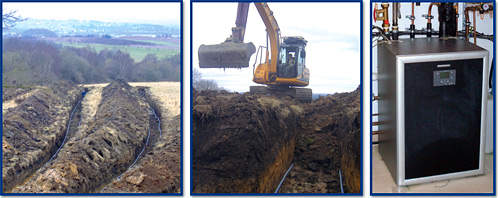Ground Source Heat Pumps
Ground Source Heat Pumps are accredited under the Microgeneration Certification Scheme as an MCS approved technology. This means as an MCS Accredited installer you are able to install MCS Accredited Ground Source Heat Pumps and offer consumers The Renewable Heat Incentive (RHI) and Renewable Heat Premium Payments (RHPP). Ground source heat pumps are also eligible under the Green Deal.

Ground source heat pumps use pipes buried in the garden to extract heat from the ground. This is usually used to heat radiators or underfloor heating systems and provide hot water.
Although we may not know it heat pumps as a technology are very familiar to us - domestic fridges and air conditioners are two examples. Ground source heat pumps (GSHP) transfer heat from the ground into a building to provide space heating and domestic hot water.
For every unit of electricity used to pump the heat, 3-4 units of heat are produced. As well as ground source heat pumps, air source and water source heat pumps are also available.
How much are you estimated to save?
|
Fuel Displaced |
£ Saving per year |
CO2 saving per year |
|
Gas |
£410 |
1.2 tonnes |
|
Electricity |
£1000 |
7 tonnes |
|
Oil |
£750 |
1.8 tonnes |
|
Solid |
£350 |
6.5 tonnes |
How does it work?
There are three important elements to a GSHP:
- The ground loop. This is comprised of lengths of pipe buried in the ground, either in a borehole or a horizontal trench. The pipe is usually a closed circuit and is filled with a mixture of water and antifreeze, which is pumped round the pipe absorbing heat from the ground.
- A heat pump. This has three main parts:
- the evaporator - (e.g. the squiggly thing in the cold part of your fridge) takes the heat from the water in the ground loop;
- the compressor - (this is what makes the noise in a fridge) moves the refrigerant round the heat pump and compresses the gaseous refrigerant to the temperature needed for the heat distribution circuit;
- the condenser - (the hot part at the back of your fridge) gives up heat to a hot water tank which feeds the distribution system.
- Heat distribution system. Consisting of under floor heating or radiators for space heating and in some cases water storage for hot water supply.
What options are available?
The ground loop can be:
- borehole;
- straight horizontal - trench costs less than a borehole, but needs more land area;
- spiral horizontal (or 'slinky coil') - needs a trench of about 10m length to provide about 1kW of heating load.
How much does it cost?
Installation
A typical 8-12kW system costs £6,000-£12,000 plus the price of connection to the distribution system. This can vary with property and location.
Running costs
The efficiency of a GSHP system is measured by the coefficient of performance (CoP). This is the ratio of units of heat output for each unit of electricity used to drive the compressor and pump for the ground loop. Typical CoPs range from 3 to 4 although some systems may produce a greater rate of e. The higher end of this range is for under-floor heating, because it works at a lower temperature (30-35ºC) than radiators. If grid electricity is used for the compressor and pump, then you should consult a range of energy suppliers to benefit from the lowest running costs, for example by choosing an economy 7 or economy 10 tariff.
Ground source heat pumps and your home
What to keep in mind when considering a ground source heat pump.
- The type of heat distribution system. GSHPs can be combined with radiators but underfloor heating is better as it works at a lower temperature.
- Is there space available for a trench or borehole to accommodate a ground loop?
- Is the ground suitable for digging a trench or borehole?
- What fuel is being replaced? If it's electricity, oil, LPG or any other conventional fossil fuel the payback will be more favourable. Heat pumps are a good option where gas is unavailable.
- Want to be 100% renewable? Buy green electricity, or install Solar PV or some other form of renewable electricity generating system to power the compressor and pump.
- Need a back-up heating system?
- Is there also a cooling requirement?
- Is the system for a new building development? Combining the installation with other building works can reduce costs.
- Can you incorporate insulation measures? Wall, floor and loft insulation will lower your heat demand.
The estimated costs can often be quickly covered by the Renewable Heat Incentive and Renewable Heat Premium Payments which can be offered by Microgeneration Certification Scheme (MCS Accredited) Installers who offer MCS Accredited Air Source Heat Pump Equipment. Ground source heat pumps are also eligible under the Green Deal.
Book on to a Heat Pump training course today at The Easy MCS Academy or call 0800 882 4308 to start your MCS for Ground Source Heat Pumps.





















